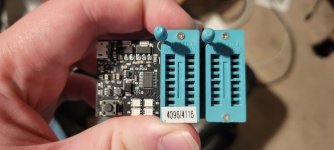EDIT: I found the video I was talking about, with the capacitor in the ZX Spectrum, starting at 4:42:
From what I heard in that video, the RAS-CAS delay is achieved via a resistor and capacitor, rather than a delay line, and a capacitor was added elsewhere to effect a small delay.
From a work-in-progress circuit diagram of your motherboard that you posted earlier, I see a delay line.
No. There is no difference in timing between addresses in 640k mode. The only thing that changes the timing is if the 256/640k jumper is installed. (Again, it's textbook perfect in 256k mode, but changes in 640k mode.)
Sorry, I meant that separately between addresses in either mode, there is no change in timing. The only change that occurs is the overall RAS/CAS/WE timing when switched-between using the 256k/640k jumper.
If I look at what IBM does in an upgrade of an IBM XT motherboard from 256K MAX to 640K MAX, I see:
1. Changing which bank RAS and CAS goes to depending on the motherboard address; and
2. Adding a 74LS158 chip to cater for the extra RAM address pin, A8.
3. Fitting 41256 class chips into banks 0 and 1.
I do not see IBM adjust the RAS/CAS/WE timing in the move to 640K MAX configuration.
BTW. In the work-in-progress circuit diagram of your board, I see that the equivalent to the 74LS158 chip above, is the chip that is labelled as 'U45 74158 (EXTRA)'.
So as I see it, a question is, does the circuit diagram indicate that the observed different RAS/CAS/WE timing is expected in 640K MAX configuration ?
If the answer is no, use the circuit diagram to hunt down the faulty component/s causing the timing change.
If the answer is yes (and the timing observed is as the circuit diagram indicates it should be), is the timing suitable for the fitted RAM chips.

